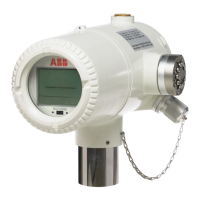126 | NGC8200 AND PGC1000 USER MANUAL | 2101510MNAH
Fault Indicates that a malfunction exists that may affect the operation of the device and
most likely will provide unexpected results. The fault will keep any affected streams
from having their data updated. However, a fault does not stop a scheduled or
manually initiated calibration from occurring; and if the calibration corrects the alarm
condition, the alarm will be cleared.
System Fault Indicates that a maintenance problem exists. Analysis processing will still occur
depending on the problem; however, results will not be updated for any stream while
this condition exists. Default system faults are already defined. Do not use this
category of alarm unless you want to stop all stream data from being updated.
11.2.1 Alarm definitions
The user can define the threshold for the alarm parameters. The analyzer provides 124 standard
alarms. Of these, the alarms in Table 11-6 are set to default. Do not change the system alarms. The
user may define additional alarms, beyond defaults, for each process stream.
Table 11-6: Default alarm definitions
Pressure Regulator 2 GT 0 Fault
Sample Pressure GT 0 Fault
Oven Temperature Error GT 0 System Fault
No Stream Valve Selected GT 0 System Fault
Calibration Un-Normalized Total GT 0 Fault
Stream Sequence Error GT 0 Fault
Calibration CV Percent Error GT 0 Fault
Out of Carrier Gas (DI1) LT 1 System Fault
Out of Cal Gas (DI2) LT 1 System Fault
GCM Chromatogram Process GT 0 System Fault
System Memory Available LT 500000 Warning
Ram File Available LT 1000000 Warning
Flash File Available LT 1000000 Warning
11.2.2 Pressure Regulator 1 or 2 Alarm
This alarm indicates low or restricted carrier pressure. The causes could be an empty or low carrier
cylinder, restricted pressure, or a blockage inside the GC module.
To troubleshoot the pressure regulator:
1. If the carrier cylinder regulator includes an installed low pressure switch, investigate if the low
carrier gas cylinder warning is also present.
2. If the low carrier gas cylinder warning is present, replace the carrier gas cylinder.
3. Verify the carrier gas cylinder pressure is above 90 PSIG. If the pressure is below 90 PSIG,
replace the carrier gas cylinder.
4. Verify the carrier gas cylinder pressure regulator set point is 90 PSIG. If not, correct the set
point to 90 PSIG.
5. Verify the column vent 1 (CV1) and 2 (CV2), sample vent (SV) and gauge port vent (GPV) are
open and unobstructed.
6. Check the sampling system for leaks and tubing restrictions. Repair the leak or restriction, if
found.

